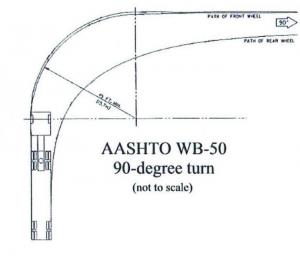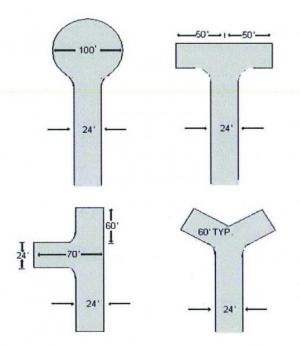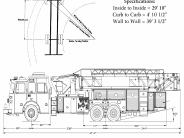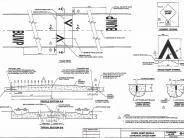Fire Lane Specifications
What Is the Legal Basis for Requiring Fire Lanes?
The International Fire Code and Addison ordinance (006-012) provide for emergency vehicle access to any building, structure or location within the Town. The Fire Marshal is responsible for ensuring that emergency access is available at all times and that all new and existing developments comply with emergency access requirements.
Is There a Difference Between a Fire Lane and a Private Street?
Private streets are regulated by the Town's private street ordinance (006-036). As such private streets may conform to a different design standard than designated fire lanes. However, they must always allow for appropriate emergency access just as a public street would and may, in some cases, be required to have fire lane markings.
Under What Circumstances Are Fire Lanes Required?
Fire lanes are generally required when any portion of a structure is located more than 150-feet from a public street. On occasion, emergency access requirements may be modified to be more or less stringent depending on circumstances unique to each site ( e.g. occupancy type, building design, parking layouts or landscape features).
What Are The Dimensional Requirements for a Fire Lane?
 Fire lanes must have a minimum of 24- feet wide working area between marking stripes and have an overhead clearance of not less than 14-feet. All curve or turn radii must be sufficient to accommodate the turning profile of the Town's largest emergency apparatus. This may be accomplished by the use of minimum turn requirements for an AASHTO WB-50 vehicle. Rather than specify a minimum inside and outside radii, this approach allows the designer to consider all aspects of the site which may affect the turning and positioning of emergency apparatus. Conformance with this policy must be demonstrated by including a scale illustration on the submitted site plan showing the turning of an AASHTO WB-50 vehicle within the proposed fire lanes.
Fire lanes must have a minimum of 24- feet wide working area between marking stripes and have an overhead clearance of not less than 14-feet. All curve or turn radii must be sufficient to accommodate the turning profile of the Town's largest emergency apparatus. This may be accomplished by the use of minimum turn requirements for an AASHTO WB-50 vehicle. Rather than specify a minimum inside and outside radii, this approach allows the designer to consider all aspects of the site which may affect the turning and positioning of emergency apparatus. Conformance with this policy must be demonstrated by including a scale illustration on the submitted site plan showing the turning of an AASHTO WB-50 vehicle within the proposed fire lanes.
How Many Points of Access Are Required?
Structures exceeding three stories or 30-feet in height shall have fire lanes along three sides of the building. One or two story buildings shall have fire lanes on two sides if they have a gross area of more than 62,000 square feet.
What Types of Structural Material Are Allowed?
Fire lanes must be constructed of an approved all-weather material capable of supporting a 100,000-pound vehicle. The design engineer or architect shall certify that the paved surface complies with this requirement.
What is the Maximum Grade or Slope Allowed?
Fire lanes and other emergency vehicle access routes must not exceed a 10% grade or incline on any plane. Grades for cul-de-sacs and turnarounds may not exceed 6%.
Are Dead-End Fire Lanes Allowed?
 Continuous fire lanes which connect to more than one outlet are preferred, however, it is understood that site limitations may not allow this in every case. Therefore, a dead-end fire lane may be allowed in certain cases provided it does not exceed 100-feet in length. If a distance in excess of 100-feet is necessary, a turnaround feature must be incorporated as part of the designated fire lane. Turnarounds must be of an approved design which meets the dimensional requirements of the other portions of the fire lane and which approximates those examples shown here. Other designs may be acceptable if approved by the Fire Marshal.
Continuous fire lanes which connect to more than one outlet are preferred, however, it is understood that site limitations may not allow this in every case. Therefore, a dead-end fire lane may be allowed in certain cases provided it does not exceed 100-feet in length. If a distance in excess of 100-feet is necessary, a turnaround feature must be incorporated as part of the designated fire lane. Turnarounds must be of an approved design which meets the dimensional requirements of the other portions of the fire lane and which approximates those examples shown here. Other designs may be acceptable if approved by the Fire Marshal.
Can "Speed Bumps" or Other Traffic Calming Devices Be Placed in Fire Lanes?
We understand and support the desire for safe streets and vehicle/pedestrian interfaces. Islands, roundabouts, bump-outs and other similar features may be incorporated within a fire lane in limited areas providing they reduce the width of the fire lane to no less than 20-feet and do not present an impediment to emergency operations. These features will be approved on a case-by-case basis. The use of "speed bumps" is highly discouraged, however, these too will be considered if no alternative is available to enhance pedestrian safety.
How Must a Fire Lane Be Marked?
Fire lanes must be marked, as shown below, by a 6-inch wide, durable red stripe running the entire length of the fire lane on both sides. The words "FIRE LANE NO PARKING" shall be applied in 4-inch white lettering at 30-foot intervals. Whenever possible all markings will be placed on curbs.
![]()
Where necessary, fire lanes may be marked in alternative manners as approved by the Fire Marshal. If such an alternative designation is allowed but fails to effectively control parking, then the standard red-stripe marking will be installed.
Can Fire Lanes Be Gated or Obstructed for Security Purposes?
The gating of fire lanes will be considered on a case-by case basis. If allowed, the installed gate must be controlled via a Knox™ Rapid Entry System. An approved manual releasing mechanism must also be installed so the gate may be opened in the event of a power failure or system malfunction. Removable bollards, subgrade "pop-up" barriers or similar arrangements are disallowed for use in fire lanes.
Can a Single Fire Lane Serve Two or More Buildings?
This is not preferred because of the potential legal complications, however, it is possible in some cases provided the emergency access is suitable and all interested parties agree. The fire lane must be legally platted as a mutual access easement which cannot be changed or impaired without the consent of all parties served.
Are There Any Alternatives or Exceptions To This Policy?
It is the desire of the Addison Fire Department to be as flexible as possible without compromising safety. Several specific exceptions are noted above, but if you have an alternative proposal we will consider it carefully. Alternatives may be approved by the Fire Chief if the design allows for adequate emergency access and deviations from City Ordinance and this policy are justified by specific site considerations.
For further information, please contact the Addison Fire Department at 972-450-7201.


